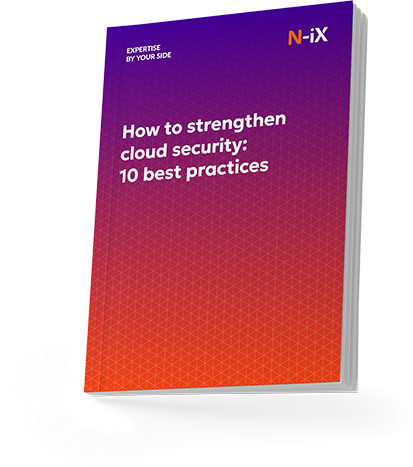CheckPoint’s 2024 cloud security report reveals that 91% of organizations prioritize AI adoption for their security strategy. Artificial Intelligence can strengthen defenses through advanced threat detection, automated responses, and predictive security, helping address sophisticated attacks and the complexity of multi-cloud environments.
But how to implement AI in cloud security? And what challenges are associated with this innovation? We gathered all the answers backed by the expertise of our security consultants in this article.

How AI strengthens cloud security: 7 practical use cases
By leveraging Machine Learning, Deep Learning, and predictive analytics, AI empowers organizations to proactively address cloud threats, streamline security operations, and ensure compliance. Below are key use cases of AI in cloud security with practical tips from our security experts.
1. Automated threat detection and response
AI-powered systems excel at identifying and neutralizing threats in real time, drastically reducing the window of exposure. Unlike rule-based tools that rely on predefined signatures, AI analyzes vast datasets, such as cloud logs, network traffic, and endpoint activities, to detect anomalies and suspicious patterns. When threats like ransomware or DDoS attacks are identified, AI can autonomously trigger responses, such as isolating systems or blocking malicious IP addresses.
Our cloud security consultants recommend leveraging advanced ML frameworks, such as TensorFlow, and developing custom algorithms to power automated threat detection. This approach ensures rapid response times for clients across various industries, reduces potential damage, and maintains scalability in enterprise-grade cloud setups.
Learn more: Exploring Agentic AI cybersecurity: Top use cases and challenges
2. Enhanced anomaly detection
Automated anomaly detection is one of the key use cases of how AI impacts cloud security, identifying deviations from standard operational patterns that may signal breaches. AI models establish baselines for user activity and resource usage, flagging anomalies for further investigation and analysis.
Another standout example is malware detection, where AI analyzes file behavior to uncover zero-day threats. N-iX security experts suggest integrating AI-driven anomaly detection with tools like Splunk and developing anomaly-scoring systems to enhance precision and accuracy. This helps fortify cloud environments by continuously adapting models to new attack patterns.
Secure your cloud with 10 best practices—get the guide now!


Success!

3. User behavior analysis
AI enhances protection through user and entity behavior analytics (UEBA). It monitors and analyzes the actions of users and entities to detect potential insider threats or compromised accounts. In a cloud environment, where remote access and shared resources are common, distinguishing between legitimate and malicious user activity is challenging.
You can train AI models on behavioral profiles for each user based on login patterns, data access habits, and typical workflows. If a user suddenly accesses sensitive data at odd hours or from an unfamiliar location, AI raises an alert. This capability is invaluable for detecting account takeovers, privilege abuse, or insider threats, ensuring that cloud systems remain secure from both external and internal risks.

4. Security automation
AI-driven security automation streamlines repetitive and time-consuming security tasks, such as vulnerability scanning, patch management, and incident response. For instance, AI in cloud security can prioritize vulnerabilities based on their potential impact and automatically apply patches or recommend mitigation strategies.
To automate security operations, our engineers recommend integrating artificial intelligence with security information and event management (SIEM) systems. It enables correlating events across multiple cloud platforms and reducing alert fatigue for security teams by filtering out false positives. By incorporating AI into orchestration scripts, you can also automate vulnerability remediation and event correlation across multi-cloud platforms to maintain robust threat protection.
5. Compliance and audit intelligence
Ensuring compliance with regulations such as CCPA, GDPR, and PCI-DSS is particularly challenging in cloud environments, where data is often dispersed across multiple regions and service providers. AI can simplify compliance by continuously monitoring cloud security configurations, data handling practices, and access controls to ensure alignment with regulatory requirements. N-iX consultants recommend leveraging AI-driven compliance monitoring platforms, such as AWS Config, combined with NLP models. This approach automates audit processes across jurisdictions, ensuring adherence to evolving mandates while minimizing manual effort.
6. Deception technology
AI-powered deception technology is an innovative approach to cloud security that involves creating decoys or honeypots to mislead attackers. These decoys mimic real cloud assets and are designed to lure malicious actors away from critical systems. AI enhances deception by analyzing attacker behavior within these traps, learning their tactics, techniques, and procedures (TTPs), and using this intelligence to strengthen overall defenses.
N-iX engineers recommend deploying dynamic, adaptive decoys that evolve based on real-time threat intelligence, ensuring attackers focus on fake targets. This strategy allows security teams to effectively neutralize threats while gaining the time needed to protect genuine assets. Thus, deception technology is among the most prominent AI cloud security examples, reshaping modern defense strategies.

7. Predictive risk management
Predictive risk management enables the anticipation and mitigation of threats before they materialize. Using AI, you can analyze historical data, current threat intelligence, and emerging trends to forecast potential vulnerabilities and attack vectors in cloud environments.
According to the provided insights and risk scores, you can prioritize security investments in your organization, allocate resources effectively, and proactively strengthen defenses against future threats.
Read more: Generative AI in cybersecurity: Top 10 use cases
Overcoming the challenges of implementing AI in cloud security
While AI offers transformative benefits for security strategies, its implementation brings some challenges. Below, we explore key risks associated with AI and cloud security and provide actionable solutions from our security team to address them effectively.
Data privacy concerns
One of the most critical challenges in deploying AI for cloud security is ensuring data privacy. AI models rely on a large volume of data, including sensitive user information, transaction logs, and system metadata, to train and detect threats. In multi-cloud or hybrid cloud environments, where data is frequently stored across different environments, this raises concerns about compliance with privacy regulations like GDPR or CCPA.
Tip from N-iX experts: N-iX security specialists recommend adopting a privacy-by-design approach when implementing AI in cloud security. This involves anonymizing and pseudonymizing data before it is used for training AI models, ensuring that personally identifiable information (PII) is protected. N-iX also advises implementing strict access controls and encryption for data at rest and in transit, coupled with regular audits to ensure compliance with global privacy standards.
High computational demands
AI algorithms, particularly those involving deep learning for threat detection or anomaly analysis, require significant computational resources. Training and running these models demand powerful hardware, substantial storage, and optimized cloud infrastructure, which can drive up costs and strain budgets.
Tip from N-iX: To tackle this issue, you can leverage serverless architectures and auto-scaling cloud services to allocate resources based on demand. Partnering with cloud providers that offer GPU-accelerated environments or AI-specific hardware can also enhance performance while minimizing energy consumption.
Integration сomplexity
Integrating AI-powered security solutions into current cloud infrastructures can be complicated because of the diverse and complex nature of cloud environments. Organizations often employ multi-cloud or hybrid cloud setups with diverse tools, platforms, and legacy systems, making the seamless integration of AI technologies a complex task.
Tip from N-iX: Our security professionals recommend following a phased and modular approach to integration to mitigate complexity. Start by assessing your cloud architecture to identify integration opportunities and detect potential bottlenecks. Use API-driven AI solutions that can easily connect with diverse cloud platforms and security tools, ensuring interoperability. It is also essential to have advanced security expertise internally or partner with experienced vendors to bridge knowledge gaps and ensure a smooth implementation.
Risk of over-reliance
While AI enhances cloud defenses through automation and predictive capabilities, there is a risk of over-reliance on these systems. Organizations may become overly dependent on AI-driven insights, neglecting human oversight and critical thinking in security operations. This can be challenging when AI models produce false positives or miss sophisticated attacks due to incomplete training data or adversarial manipulation.
Tip from N-iX: Our security experts recommend maintaining a balanced approach by combining AI capabilities with human expertise. Establish a human-in-the-loop (HITL) framework, where AI systems flag potential issues, but security teams review final decisions on critical actions. Regular adversarial and stress testing of AI models should be conducted to detect weaknesses and improve resilience against manipulation. It is also crucial to cultivate a culture of continuous learning within your personnel to ensure they remain vigilant and capable of addressing threats that AI might miss.
Read more: Top cloud security trends to protect your business in 2025
How N-iX helps leverage AI in cloud security
As attack surfaces expand with the adoption of cloud platforms, the combined power of AI and cloud computing security provides a dynamic and proactive defense against evolving risks. N-iX drives this evolution with expertise in adaptive detection, anomaly monitoring, and predictive analysis, shifting security from a reactive to a proactive approach.
N-iX adopts a comprehensive approach to AI-driven cloud security, founded on a robust data foundation and supported by governance frameworks that ensure regulatory compliance. Backed by 2,400 technical professionals, 100+ security-focused projects, and industry-recognized certifications, including ISO 27001, GDPR, CCPA, PCI DSS, and others, N-iX delivers security solutions that address emerging challenges in cloud security and AI.
Ready to strengthen your cloud defenses with AI-powered solutions? Contact N-iX today to begin your journey toward a more secure cloud infrastructure.
Have a question?
Speak to an expert




